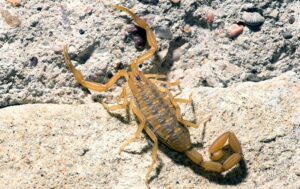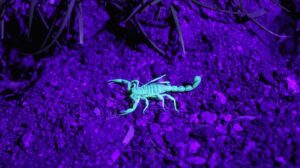Pest Library
Area sees its fair share of pest problems, and knowing which pests you’re dealing with when you find one in your home or business is helpful for several reasons. Our pest library provides helpful information about our areas most common pests, including what they look like, if they are a cause for concern, and how to get rid of them.
Scorpions
Scorpions thrive in dry, desert-like conditions making a place where home and business owners often run into them. Some of the more common species in our area include the desert bark scorpion, giant desert hair scorpion, brown scorpion, and wind scorpion (sun spider).
No matter the species, avoiding contact with scorpions is important. They are a type of stinging pest and will use the stinger found at the end of the tail to defend themselves. The venom a scorpion possesses is strong enough to cause an allergic response in people. If ever stung by a scorpion, seek medical attention immediately.
While scorpions do prefer desert conditions, they also require moisture. During the heat of the day, these critters hide either in an underground burrow or under things like woodpiles, rocks, landscaping ties, or under trash cans. At night they emerge to hunt for crickets, spiders, cockroaches, and other small prey. Moisture and cooler living conditions often draw scorpions to a home.
If the weather is very hot and dry, they will move inside through cracks in the foundation or exterior walls, holes screens, or gaps around windows and doors. Once inside, they move to the damp, cool areas of a home like bathrooms (sinks and tubs), kitchens, and basements. Scorpions tend to travel in groups, so if you spot one in or around your home, know that more are lurking nearby.

Scorpion Stings & Treatment
Most of the scorpions that enter homes are not poisonous; but if you are unsure it’s usually better to assume that they are poisonous. Of the estimated 1,400 species of scorpions, only about 20 to 25 can inflict potentially fatal stings. Scorpion stings are most serious in young children, older adults, and pets.
scorpion stings are mostly harmless and the majority of healthy adults don’t need treatment for scorpion stings. Their stings are painful – similar to bees or wasps. A person who has been stung may feel a painful, tingling, burning or numbing sensation at the sting site.
The sting usually causes discomfort that ranges from moderate to severe depending upon the individual scorpion and the person’s reaction to the venom. An ice pack applied to the affected area will relieve some pain and the symptoms should decrease over time. A person who is stung by a scorpion should be watched closely for adverse allergic reactions.
only one species (the bark scorpion), found mainly in the desert Southwest, has venom potent enough to cause severe symptoms. Scorpion stings can pose a medical threat especially to the young, elderly, and pets. Get immediate medical care for any child stung by a scorpion.
If you are experiencing any of the following serious symptoms go to the Emergency Room immediately:
Breathing difficulties;
Difficulty swallowing or talking;
Dizziness;
Drooling/Salivation;
Extreme or persistent pain;
Hyperactivity;
Muscle twitching or thrashing;
Numbness that spreads to entire extremity;
Paralysis of area or extremity;
Unusually high or low blood pressure;
Vomiting;
Weakness;

BE IN THE KNOW! HERE ARE A FEW IMPORTANT FACTS ABOUT SCORPIONS
chances are that sooner or later a scorpion is going to cross your path-or living room floor. Either way, you are going to be anything but excited and may feel disgusted or even scared. And while your initial reaction may be to go ahead and take care of the scorpion problem by burning down the house, you should take a step back and evaluate what other options of scorpion control are available to you. Plus, how much do you really know about scorpions?
Scorpion Species in Mesa and Beyond
The bad news is that there are several scorpion species that call Mesa their home, however, the good news is that most of them aren’t dangerous and/or poisonous.
The striped-tail scorpion is, according to the Desert Museum, the most common scorpion. It can be found virtually anywhere from the desert to the mountains, sea level and beyond. It gets its name from the distinct dark ridges on the underside of its tail. It measures about 2 inches in length and likes to hide under rocks during the day like most Mesa scorpions do.
One of the less common scorpions in the Mesa area is the giant desert hairy scorpion. While it is an active and aggressive scorpion, its venom is not very potent and thus it is not really big on our scorpion watch list.
The Bark Scorpion is one of the most common scorpions in Mesa and surrounding areas. Unfortunately, it is only the most dangerous one and the only species that is willing to climb walls and trees, making it a frequent visitor in your home. And because they like to be upside down, people often get stung from a scorpion that is on the bottom of something.

Scorpions to Snakes: Here’s What Not to Do if Stung or Bitten
When spring and summer arrive, soon you might start to hear about snakes sunbathing on trails and scorpions skittering about. These crazy critters can add a little bit of suspense to your day if you encounter them.
Scorpion Stings
Do Not Panic
Most patients can safely observe for and manage symptoms from a scorpion sting at home.
Do not apply ice to the sting site
Instead: Ice may feel good when applied but once removed, the pain will return with worse intensity. Instead, use a cool compress. Use several small towels and soak them in a bowl of ice water. Apply one of the cool compresses to the sting site and rotate it with another freshly cooled towel from the bowl as needed.
Do not try to trap or retrieve the scorpion for identification
Instead: This puts you at risk for another sting. You can instead kill the scorpion and dispose of it if it’s inside your home. “The identification won’t alter what symptoms to look for or what treatment options you have,”
“While bark scorpions are a smaller relative to other species of scorpions, “baby scorpions” are not more harmful or deadly. The age of the scorpion doesn’t determine the extent to which symptoms will occur, just the species.”

Why Are There Scorpions In My House? Here’s Why – And How to Get Rid of Them
Just the name alone is enough to invite a shudder to run through your entire body – scorpions. The exact creature that is guaranteed to be in a creepy movie or thriller, either as an obstacle for the main characters to pass on the way to find an exit or as a tool to pressure someone into a confession of some sort.
These creatures have been around for millions of years thanks to their skills of survival which allows them to adapt to various weather changes, conditions, and climate changes. But what is it that attracts scorpions to your home and once they have taken up unfortunate residence; how can you get rid of them? Let’s find out
What is a Scorpion?
Scorpions are members of the aforementioned Arachnid family and are closely related to the insect population. With almost 2,000 different species, it is a fortunate thing that only approximately 30 or 40 species of scorpions are poisonous to humans. While most scorpions still have venom running through their stinger at the end of their tail; the venom isn’t enough to fatally harm an adult. They typically dine on insects but have proven to be greater than average when it comes to adapting; as they can slow their metabolism in times of a food shortage. When a scorpion slows its metabolism, it can survive on one insect per year but still possess the speed and strength needed to take down prey.
Scorpions have shown during field studies an incredible set of survival skills, with a tool to counter any problem they encounter, from frozen conditions to a lack of oxygen and food. The only true weakness per say that they have, would have to be the need of soil for survival. As a burrowing creature, they must have loose soil to hide, sleep, mate, etc. Scorpions are described as a hard-shelled arthropods with eight legs and a tail. Some of the species can even glow in the dark due to ultraviolet light entering and then reflecting off the shell. The tail is a curved shape that is broken up in individual segments and ends in a barb or stinger point.
An Abundance of Moisture in the Home
If moisture levels are high in your home due to natural circumstances, such as you live in an area that is prone to flash-flooding or flooding due to the seasonal changes, you might see scorpions throughout the residence looking for water. One of the top reasons a scorpion will enter a home is to primarily search for water and then food.